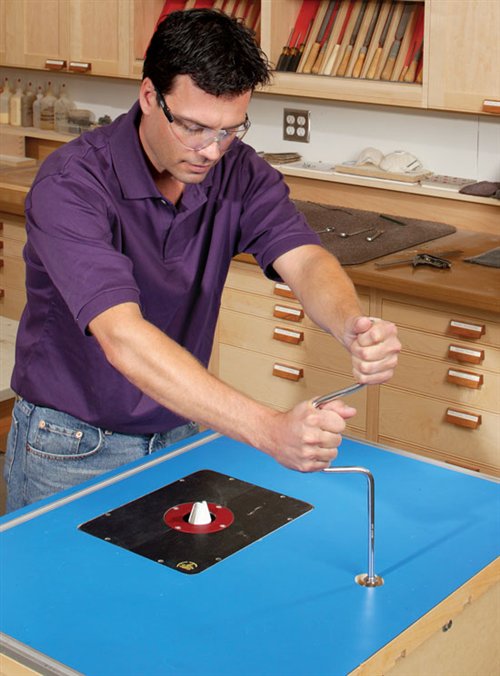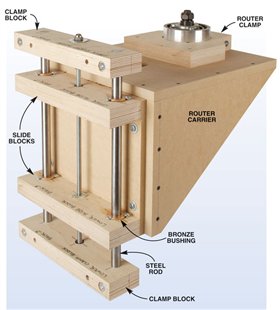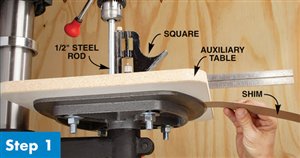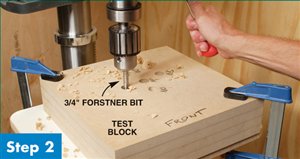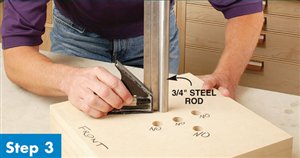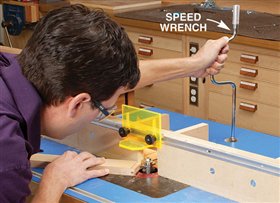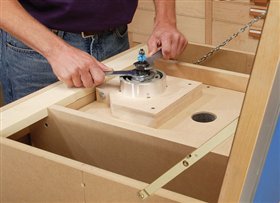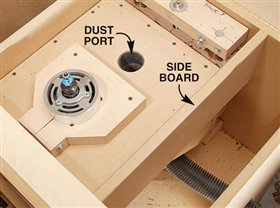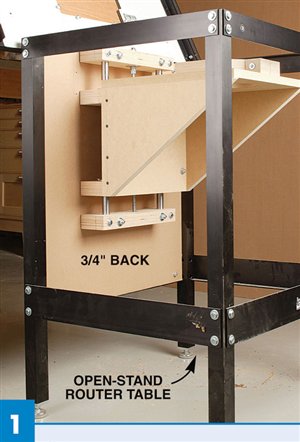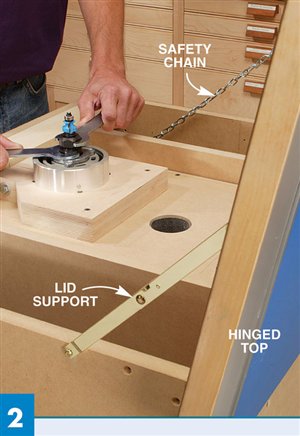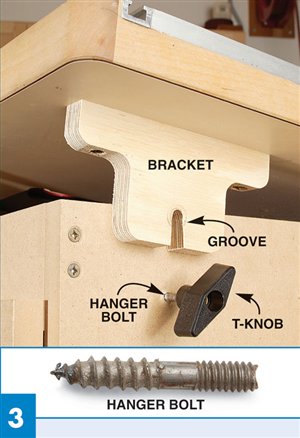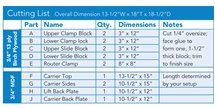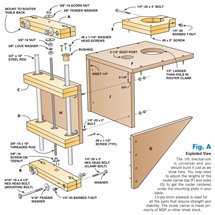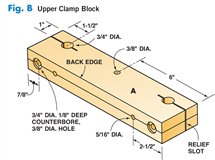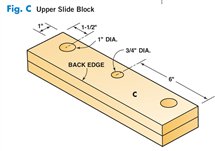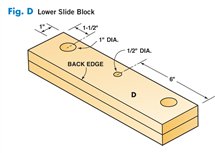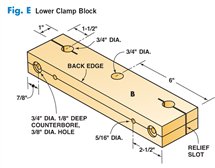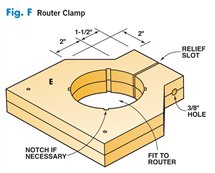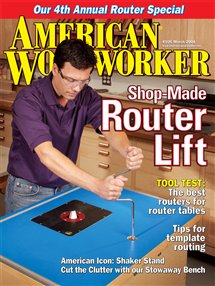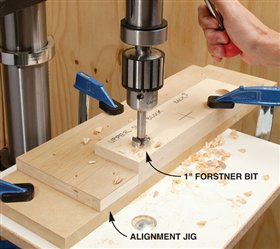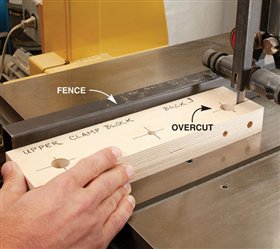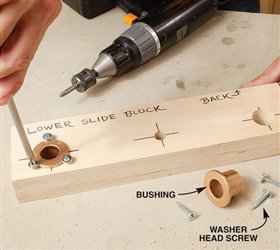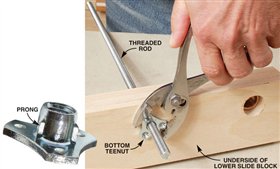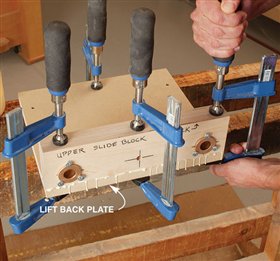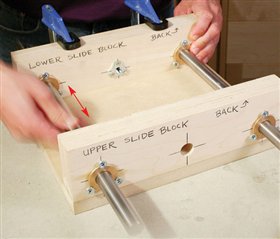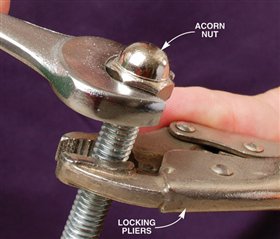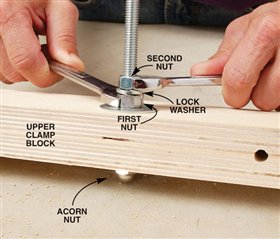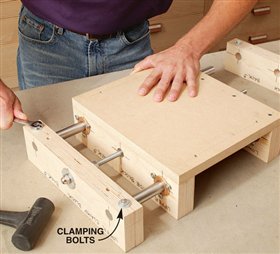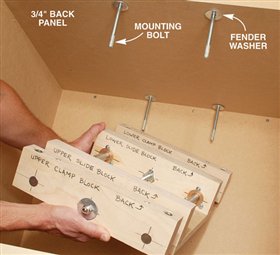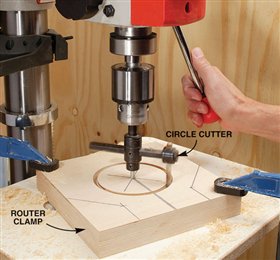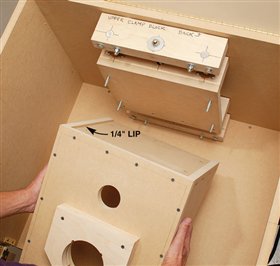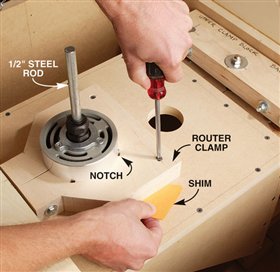We may receive a commission when you use our affiliate links. However, this does not impact our recommendations.
Shop-Made Router Lift
Features you can’t buy at a price you won’t believe.
By Bruce Kieffer and Richard Tendick
Router lifts are hot items these days and for good reason. Veteran router table users love their ability to make super-fine micro adjustments or rapidly raise the bit right from the tabletop. No more fumbling under the table like a contortionist.
The only drawback is the price: $200 to $500. Ouch! That’s why we were so thrilled when Richard Tendick walked into our offices with his idea for a shop-made router lift. Not only does Richard’s lift offer above-the-table height adjustment (see “Benefits of the AW Router Lift,” page 40) but it costs less than $100. Plus, unlike the expensive commercial lifts, this lift allows you to change bits without cranking the router all the way up. It also features effective below-the-table dust collection. When combined with dust collection in the fence it results in near-perfect dust collection. This design also isolates the exhaust end of the router in the cavity. That leaves the router air intake sucking only clean, dust-free air. And, unlike all the other mechanical lifts on the market, Richard’s lift hangs off the back of the router table, not on the top where the excess weight can lead to sagging.
FeaturesOur router lift consists of two components: the lift mechanism and the router carrier. The lift mechanism uses finely machined steel rods that slide through oil-impregnated bronze bushings set in upper and lower slide blocks. Upper and lower clamp blocks capture the ends of the steel rods and provide attachment points for securing the lift to the router table back. The router carrier attaches to the lift mechanism. A plywood router clamp holds the router motor in the carrier. Adjusting the height is as simple as turning the acorn nut on top of a threaded rod. |
Click on any image to view a larger version. |
| If you’re groaning because this sounds like one of those tedious projects that require machinist-level tolerances, stop fretting. This project is really dirt simple. We’ll show you a few simple tricks, like fine-tuning your drill press (see “Super-Tune Your Drill Press,” above) that guarantee a smooth-running lift. Will it fit my router table?If you already own a full-size router table don’t sweat. A few simple modifications allow you to mount the AW lift into most commercial tables (see “Fitting the AW Lift to Your Router,” above) We put our lift into our “AW Best Buy Router Table”. What you’ll needThis project requires some specialized hardware unfamiliar to most woodworkers, like bronze bearings and steel rod. We recommend you buy your lifter parts from the mail order sources we used (see Sources, below). We know all of these parts work in harmony with each other. Plus, our source for the steel rods will cut them to length for no charge and that’ll save you a lot of work. Besides the hardware, you’ll need a tablesaw, bandsaw, drill press, heavy-duty circle cutter, and 3/4- and 1-in. Forstner bits. Build the lift mechanism1. Cut and assemble the slide and clamp-block blanks (A–D) (Photo 1). 2. Lay out the holes on the clamp and slide blocks as shown in Figs. B through E, below. Be sure to mark the back edge of each blank. 3. Make a jig to register the clamp and slide blocks on the drill press (Photo 2). The jig is simply a board onto which pieces of wood are nailed to form a cradle around the plywood blanks. This guarantees perfect hole alignment from block to block, which is critical to the smooth operation of the lift mechanism. 4. With the jig and a blank in place, set the table height on your drill press low enough to allow the longest bit to be taken in and out without moving the table. 5. Clamp the upper slide block in the drilling jig. Insert a 1-in. Forstner bit in the drill press and align its point with a bushing hole center point. Clamp the drilling jig to the drill press table and drill this hole. Don’t move the drilling jig! Pull the upper slide block out of the jig, clean the jig if necessary, and insert the lower slide block, clamp and drill. 6. Switch to a 3/4-in.-diameter Forstner bit and drill the clamp holes in the upper and lower clamp blocks. 7. Now position the drilling jig to drill the opposite side holes following the same drilling sequence. Don’t be tempted to just flip the blanks over to drill the second set of outside holes. Any error in the perpendicularity of the holes will get magnified. 8. Move the drilling jig and drill the center holes for the threaded rod and the screw on teenuts. 9. Lay out and drill the counterbore holes (Figs. B and E) for the barbed T-nuts on the upper and lower clamp blocks. 10. Drill the through-holes for the clamp bolts and mounting bolts. 11. Saw relief slots in the clamp blocks (Photo 3). 12. Hammer the barbed T-nuts into the clamping hole recesses. 13. Mount the bronze bushings in the upper and lower slide blocks with washer head screws (Photo 4). Washer heads are screws with a built-in flat washer under the head. The edge of the washer head catches the flange of the bushing. Tip: A self-centering bit held next to the bushing flange provides the perfect setback. 14. Attach the top screw-on teenut to the lower slide block and run the threaded rod through. 15. Attach the bottom teenut (Photo 5). The double teenut system eliminates backlash (that annoying free-spin you get when changing direction on the lift mechanism) because the threads of the rod are always in tight contact with the threads of the screw-on teenuts. 16. Remove the threaded rod. 17. Cut the lift and carrier back plates (H and J) to size. Clamp these two pieces flush together and drill the four 1/4-in.-diameter holes through them for joining the router carrier to the lift mechanism (Fig. A). 18. Drill four countersunk pilot holes near the bottom edge of the lift back plate for mounting the lower slide block. Make sure the pilot holes are positioned so the screws won’t run into the bushings or threaded rod. 19. Glue the upper slide block to the lift back plate (Photo 6). 20. Grind or file a slight chamfer on the ends of the 3/4-in.-diameter steel rods. Smooth away any remaining burrs using a fine emery cloth. 21. Clamp (no glue) the lower slide block to the bottom edge of the lift back plate. Insert the steel rods through the bushings. Adjust the position of the lower slide block so both steel rods slide smoothly through the bushings (Photo 7), and attach with screws. 22. Attach the acorn nut to the top of the threaded rod (Photo 8). 23. Attach the threaded rod to the upper clamp block (Fig. A and Photo 9). 24. Slide the threaded rod with the upper clamp block attached through the hole in the upper slide block and into the screw-on teenuts mounted in the lower slide block. 25. Slide the steel rods up through the holes in the upper clamp block and tighten the clamping bolts (Photo 10). 26. Slide the lower clamp block over the steel rods and clamp it in place. The lift mechanism is now complete. Installing the lift27. Alter your router table to accept the lift mechanism. Most tables will only require a 3/4-in. back added to the cabinet (see “Fitting the AW Lift to Your Router Table” above). 28. Locate the mounting bolt holes in the back of the cabinet by clamping the lift about 3/4 in. down from the top edge of the back. 29. Use the mounting holes in the clamp blocks as guides to drill through the back panel. 30. Insert the mounting bolts through the back and mount the lift mechanism (Photo 11). Build the router carrier31. Glue up and cut the router clamp blank (E). Then lay out the pattern for the router clamp (Fig. F). 32. Cut the hole for the router (Photo 12). You’ll need some scrap to make test holes until you get a snug fit. 33. Cut off the side waste pieces, then lay out and drill the countersunk hole for the T-nut and the through-hole for the clamp bolt. Secure the router clamp in a vise for easier drilling. 34. Cut the router clamp relief slot on the bandsaw. Some routers have locating pins on their sides that require notches (Photo 14) to be cut inside the opening. This can also be done with the bandsaw. 35. Assemble the router carrier (F, G and J, Fig. A). Don’t use glue for the carrier top (F). Be sure to keep a 1/4-in. inset on the carrier back. This creates the lip to hang the carrier onto the lift mechanism. 36. To locate the hole in the router carrier top, temporarily mount the carrier on the lift with a couple of bolts. Close the router tabletop and crank the lift all the way up. Scribe the bit opening in the tabletop onto the carrier top. 37. Remove the router carrier from the lift. Remove the carrier top and router clamp. 38. Drill a hole in the router carrier top using the bit opening as a center point. Make the hole 1/2-in. larger than the hole you drilled in the router clamp. 39. Adjust the circle cutter and cut the hole for the vacuum hose. 40. Reattach the carrier top. Set the router with the clamp attached in the hole. Close the top and center the router in the opening. Open the top and screw down the router clamp. 41. Remount the router carrier to the lift mechanism using bolts (Photo 13). 42. Mount your router in the router clamp and tighten the clamp bolt. The router should protrude out of the router clamp an inch or so (Photo 14). 43. Add a couple of 6-in.-wide sidepieces to enclose the router lift for more effective dust collection. 44. That’s it! You’re ready to rout! Sources(Note: Product availability and costs are subject to change since original publication date.) Home Center, One 3/4″ x 24″ x 48″ MDF; Four 5/16″-18 x 4-1/2″ Hex Head Machine Bolts, Fender Washers, Washers and Lock Nuts; Four 1/4″-20 x 3″ Hex Head Machine Bolts and Washers; Two 3/8″ Fender Washers; One 3/8″-16 Acorn Nut and Lock Washer; Two 3/8″-16 Hex Nuts; Four 1/4″-20 x 2″ Hex Head Machine Bolts, Lock Nuts and Washers; One 1/4″-20 x 4″ Hex Head Machine Bolt and Washer; One 3/8″-16 x 18″ Threaded Rod. McMaster-Carr, mcmaster.com, 609-689-3415, 3/4″ x 18″ x 36″ Round Shafting, #8924K393; Four Bronze Oilite Sleeve Bearings, 3/4″ ID x 1″ OD, #6338K433. Rockler, rockler.com, 800-279-4441, One 3/4″ x 24″ x 30″ Finnish Birch, 13-ply Plywood, #63453; 1″ Forstner Drill Bit, #21200; 3/4″ Forstner Drill Bit, #21186; Heavy-Duty Circle Cutter, #42887; Two 3/8″-16 Screw-On Teenuts, #68387, pack of 8; Two 1/4″-20 x 1-1/2″ Hanger Bolts, #24406, pack of 8; Two 1/4”-20 x 2” Plastic T-Knobs, #71506; Twelve #8 x 1-1/4″ Washer Head Face Frame Screws, #38528, pack of 100. Parts Express, parts-express.com, 800-338-0531, Five 1/4″-20 Barbed Insert Nuts (Barbed T-Nuts), #081-1096, pack of 50. Cutting ListFig. A: Exploded ViewFig. B: Upper Clamp BlockFig. C: Upper Slide BlockFig. D: Lower Slide BlockFig. E: Lower Clamp BlockFig. F: Router ClampThis story originally appeared in American Woodworker March 2004, issue #106. |
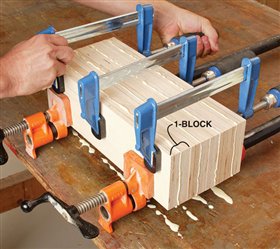
1. Build the slide and clamp blocks by gluing up plywood blanks in pairs. Keep the edges as flush as possible. Trim to finish size after the glue dries. 2. Drill holes for the bushings, steel rods and threaded rod on the drill press. A simple jig registers each blank so each set of holes is drilled in exactly the same spot. Important: Clearly label each block and mark the back edge to prevent mix-ups. 3. Cut relief slots in the clamping blocks on the bandsaw. Cut each slot 1/4-in. past the hole so the clamping blocks can squeeze tightly on the steel rods. 4. Screw in three washer head screws around each bushing. Place these screws about 1/16 in. away from the bushing edges. Don’t over tighten; you want the bushings to turn freely in their holes. 5. Attach the threaded rod to the lower slide block with a pair of teenuts, one on either side. Screw one teenut on the top of the block. File the prongs off the bottom teenut so it can spin freely in the hole, then tighten it until the threaded rod turns with just a bit of resistance. Insert the mounting screws and remove the rod. 6. Glue the upper slide block to the lift back plate. Make sure the side and top edges are flush with each other. 7. Clamp the lower slide block in place and check its alignment. The steel rods should slide smoothly. If they bind, give the lower slide block a tap with a mallet to the left or right until the rods move freely. Then secure the lower slide block with screws. 8. Lock an acorn nut onto the top of the threaded rod. Really jam it on! You want the nut locked on the rod so it can be turned in both directions without coming undone. Clamp the locking pliers close to the nut so any damaged threads get buried in the upper clamp block. 9. Attach the threaded rod to the upper clamp block by locking two nuts together. Finger-tighten the first nut against the block so the rod turns with just a slight amount of resistance. Then add a lock washer and tighten the second nut against the first. 10. Tighten the clamp blocks on the steel rods. Make sure the tops of the rods are flush with the surface of the clamp block. 11. Hang the lift mechanism on the cabinet back. Washers keep the moving parts of the lift clear of the back. Note: The cabinet back must be 3/4-in. thick to support the lift. 12. To make the carrier for your router, drill the hole in the router clamp using a heavy-duty circle cutter. Make test cuts to ensure a snug fit on the router motor body. 13. Bolt the router carrier to the lift mechanism. The lip around the back edge of the router carrier makes it very easy to align the two components. 14. Mount the router in the clamp. Chuck the 1/2-in.-diameter steel rod in the router and check that it’s square to the table. If you find the router is not perfectly perpendicular to the table, shim the router clamp. Note the notches cut in the clamp to accommodate pins on the motor housing. |
Here are some supplies and tools we find essential in our everyday work around the shop. We may receive a commission from sales referred by our links; however, we have carefully selected these products for their usefulness and quality.



